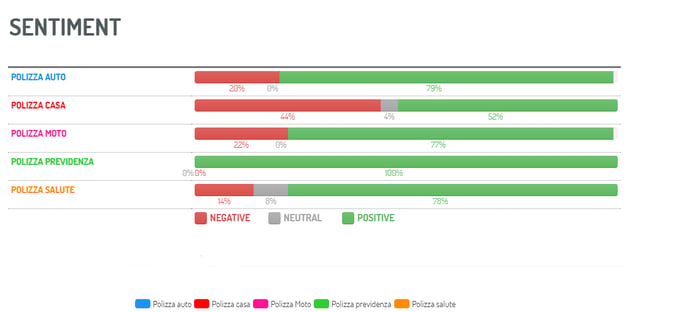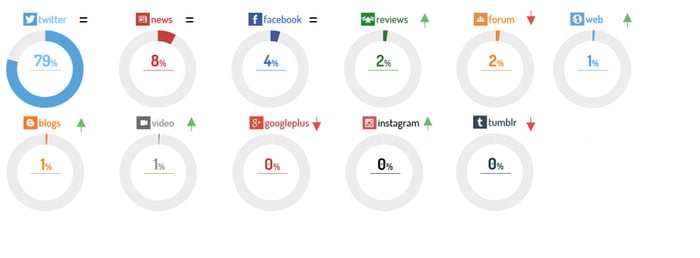3 Strategies for Insurance Companies to Optimize Their Customer Service
A case study on how insurance brands can optimize online customer care through real-time analysis of online conversations.
According to the NetConsulting study entitled "The Impact of Digitalization on the Performance of Information Systems,” 30% of the surveyed sample have implemented real-time social media monitoring solutions, however their solutions were limited to single platform monitoring systems. While they have their merit, single platform monitoring systems limit a brand’s ability to promptly respond to customer service issues and reduce the negative experiences of individual users. According to the study, only 25% of the sample have implemented centralized and multi-platform monitoring solutions which offer a more global understanding of market brand perceptions.
This data becomes more evidently significant when compared to Microsoft’s "State of Global Customer Service Report" (2016). The report indicates that 60% of surveyed consumers claim to have stopped buying a product or service as a result of poor customer service management, and 55% said that their initial interaction with a brand’s customer service takes place online. Additionally, 39% indicate that the most frustrating aspect of any customer service experience is being asked to repeat their problem several times to different operators.
These findings raise an important business opportunity linked to one of the largest challenges in a company’s digitalization process: successfully implementing new technological changes to improve a team's processes, communication, and organization.
The following is a case study of leading player in the European insurance sector and their use of Digimind’s social intelligence tool to successfully improve the efficiency of their online customer care services.
The Business Challenge
Our client felt that that social data analysis needed to be integrated into their customer care processes in order to improve customer experience across all online and social contact points. With these guidelines in mind, the company developed the following goal:
Optimize the operational efficiency of the online customer care team and build solid consumer relationships and develop customer loyalty.
 A sentiment analysis of the Italian insurance provider's policy offerings, via Digimind Social.
A sentiment analysis of the Italian insurance provider's policy offerings, via Digimind Social.
The Project
To reach their goals, our client partnered with Digimind Social in order to generate real-time social insights aimed at improving the efficiency of the online customer care team.
More specifically, the customer service and corporate communication divisions decided to use the tool to achieve the following:
- Collect and integrate online conversations across multiple sources such as social media, forums, and blogs, into accessible dashboards.
- Segment the data based on on case histories and volume of interactions.
- Create differentiated reports based on the needs of individual agents and managers.
The Solution
The project was structured to involve three strategies for improving online customer care.
1. Sentiment AnalysisThe brand set up a system in Digimind Social to monitor critical and negative comments about relevant themes, company policies, competing brands, and individual branches of the company. These data were further subdivided to analyze the growth of trends in positive or negative perceptions over time and the influence of different channels on these perceptions.
2. Alerts and Dashboards
Real-time dashboards were set up to monitor and analyze brand mentions which graphically illustrate KPI’s for the client’s reference. The client also set up an automatically forwarded notification system in order to alert the team when the volume of mentions on the brand or critical analyses reached abnormal peaks, or when certain keywords or expressions were used.
3. Collaborative Functionality
The responsibilities of account management were divided based on competence and the relationships employees had developed with client accounts based on their history of interactions. Members of the customer service team were briefed on relevant account information such as case histories, prior issues, and brand affiliates.
The project also included an internal audit of the performance of our client’s professional relationships with various brands and their subsidiaries. The audit specifically evaluated the success of each case’s management and the timelines of the partnerships.
 A graphic demonstrating the volume of mentions on each social media platform, via Digimind Social.
A graphic demonstrating the volume of mentions on each social media platform, via Digimind Social.
The Results
This automation of informational analysis and data processing systems led to strong results:
- An 8% reduction in negative online mentions of the brand within the first six months of the project.
- Simplified business procedures and reduction of process redundancies and errors.
- Optimized methods of measurement customer satisfaction and the success of customer care efforts.
The Best Practices
The results of this project highlights several best practices applicable to all online customer care projects:
Integration of Processes
Choosing the right software is integral for successfully centralizing information from multiple sources to properly profile the needs of customers. However, the software must be complemented with careful planning of related policies, processes, guidelines, and problem-solving arrangements.
Segmentation of Information
A non-focused segmentation of information will produce generic results which are difficult to interpret and will not produce operational indications for improving performance. The choice of queries, keywords, and themes must be carefully cataloged in order to accurately define a perimeter of analysis, identify priority issues, and more effectively reference and evaluate new information.

